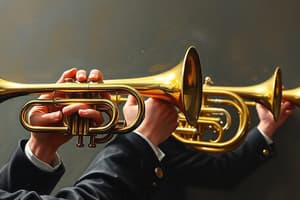Podcast
Questions and Answers
Considering the techniques used in crafting metalwork like the object in the image, which of the following steps would be most crucial in achieving intricate surface decorations?
Considering the techniques used in crafting metalwork like the object in the image, which of the following steps would be most crucial in achieving intricate surface decorations?
- Heating the metal to extremely high temperatures before applying any decorative elements.
- Using a combination of chasing and engraving to create detailed patterns and designs. (correct)
- Employing a fast-drying lacquer to prevent the metal from tarnishing during the carving process.
- Applying a thick layer of enamel to the metal surface prior to any carving or etching.
The object in the image exhibits calligraphic inscriptions. What is the most likely purpose of including calligraphy on such metalwork during its historical period?
The object in the image exhibits calligraphic inscriptions. What is the most likely purpose of including calligraphy on such metalwork during its historical period?
- To display the artisan's ability to write in multiple languages, catering to a diverse clientele.
- To serve as a protective charm against theft or damage, ensuring the object's longevity.
- To demonstrate the artisan's skill in replicating written texts without understanding their meaning.
- To convey religious verses, blessings, or poetic expressions, adding layers of meaning and cultural significance. (correct)
If the metalwork in the image was found in multiple fragments, which method would be most appropriate for reassembling and conserving it?
If the metalwork in the image was found in multiple fragments, which method would be most appropriate for reassembling and conserving it?
- Creating a new mold of the object and recasting it to replace the damaged original.
- Welding the pieces together using modern equipment to ensure a seamless and invisible repair.
- Using a strong, modern adhesive to glue the pieces together without further intervention.
- Employing a technique that involves minimal intervention, such as pinning or sleeving, to maintain the object's integrity. (correct)
Considering the historical context of similar artifacts, what role might an object like the one in the image have played in social or cultural rituals?
Considering the historical context of similar artifacts, what role might an object like the one in the image have played in social or cultural rituals?
How might the study of the metal composition in the artifact from the image inform our understanding of trade routes and technological exchange in its time?
How might the study of the metal composition in the artifact from the image inform our understanding of trade routes and technological exchange in its time?
What non-destructive analytical technique would be MOST suitable for determining the elemental composition of the metalwork in the image without causing damage?
What non-destructive analytical technique would be MOST suitable for determining the elemental composition of the metalwork in the image without causing damage?
If the metalwork shows signs of corrosion, which of the following conservation strategies would be the LEAST appropriate initial step?
If the metalwork shows signs of corrosion, which of the following conservation strategies would be the LEAST appropriate initial step?
How does understanding the original manufacturing techniques of an artifact like the one in the image aid in its long-term preservation?
How does understanding the original manufacturing techniques of an artifact like the one in the image aid in its long-term preservation?
If the artifact in the image is made of copper alloy that has undergone oxidation, resulting in a layer of green 'patina', what chemical process has occurred?
If the artifact in the image is made of copper alloy that has undergone oxidation, resulting in a layer of green 'patina', what chemical process has occurred?
Suppose the metalwork in the image contains traces of organic residue. What analytical method could be employed to identify the source of this residue?
Suppose the metalwork in the image contains traces of organic residue. What analytical method could be employed to identify the source of this residue?
Flashcards
What is a chalice?
What is a chalice?
A usually golden metal object used to contain items.
Study Notes
- This is a brass bowl inlaid with silver.
- The artifact is likely from 13th century Syria or Egypt.
- The Museum of Fine Arts in Boston currently holds it.
- It is part of the Edwin J. Holmes Fund.
Studying That Suits You
Use AI to generate personalized quizzes and flashcards to suit your learning preferences.




